As an emblem of American muscle transitioning into the electric age, the Ford Mustang Mach-E has entered the automotive arena, facing the critical gaze of value retention. Navigating the electric vehicle market trends, the Ford Mustang Mach-E depreciation rate unfolds a tale of endurance within a traditionally volatile segment. Understanding this iconic vehicle’s value trajectory post-purchase involves a thorough resale value analysis, capturing the interest of both enthusiasts and economical buyers alike.
After 5 years from rolling out of the showroom, a typical Mach-E is projected to retain 76% of its original sticker price, standing at a noteworthy $37,281 resale value from an initial offering of $49,054. This depreciation journey, however, is more than a statistic; it mirrors the impact of automotive innovation on consumer investment.
Punctuating this analysis is the Mach-E’s stand in the top 25% of popular models for holding its value across a span of 5 to 7 years. With an annual depreciation milestone charted over a 10-year span, potential owners can predict the long-term financial implications of their electric vehicular choice. Whether you are gauging a new purchase or considering entering the used market, the Ford Mustang Mach-E stands as an illuminating case study within the electric vehicle evolution.
Key Takeaways
- The Ford Mustang Mach-E showcases a depreciation rate that merits attention in the electric vehicle industry.
- Mach-E’s projected resale value remains robust at 76% after the initial five years of ownership.
- Ranking in the upper echelon for value retention, the Mach-E may set a precedence for performance-oriented EVs.
- Annual depreciation data provides a foresight into the 10-year financial landscape for Mach-E owners.
- This electric vehicle serves as a beacon for analyzing the factors influencing depreciation in emerging automobile technologies.
Introduction to the Ford Mustang Mach-E and its Market Position
The dawn of a new era in performance-oriented EVs is marked by the arrival of the Ford Mustang Mach-E, a vanguard in Ford’s pivot towards an electrified future. Balancing heritage with forward-thinking engineering, the Mach-E taps into the growing electric vehicle market adoption while promising to uphold the storied Mustang’s legacy of value retention. At its core, this electric crossover encapsulates a fusion of style, functionality, and the allure of untethered performance traditionally linked to the Mustang marque.
Joining a burgeoning segment that combines the environmental ethos with vehicular athleticism, the Ford Mustang Mach-E resonates with tech-savvy consumers and performance aficionados alike. It stands at the intersection of advanced automotive technology and long-established brand fidelity, challenging the status quo with each mile driven.
Its innovative infotainment system and performance trims underscore a commitment not only to electrification but to a comprehensive, spirited driving experience. Such advances underline Ford’s agenda in reshaping electric vehicle market adoption, influencing customer perceptions and setting a new benchmark for performance-oriented EVs. Anchored by its potential for Ford Mustang Mach-E value retention, this vehicle positions itself as not just an eco-friendly choice, but also a savvy long-term investment for prospective buyers.
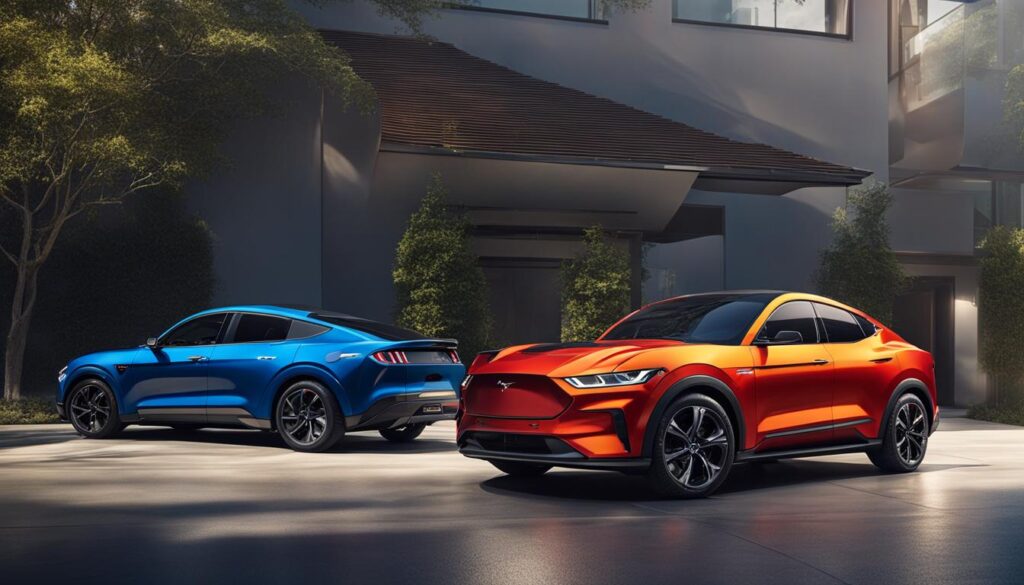
The Mach-E’s emergence propels Ford into a competitive stance within the electric vehicle dominion, ideally located to capitalize on increasing consumer appetite for EVs that do not compromise on performance or pleasure. As the Mach-E maneuvers through the dynamics of new vehicle economics, it is poised for scrutiny regarding how it retains its value against traditional internal combustion counterparts and nascent EV challengers alike.
Whether it’s the allure of cutting emissions without sacrificing horsepower that entices the enthusiast, or the fiscal prudence of exceptional resale value that appeals to the economist within, the Ford Mustang Mach-E represents more than a mere addition to the automaker’s lineup. It is a harbinger of an electrified yet thrilling future of mobility.
Ford Mustang Mach-E Depreciation Trends Over Time
When discussing the financial impact of owning an electric vehicle, the Mach-E depreciation analysis is pivotal. The Ford Mustang Mach-E, a symbol of innovation and performance in the electric vehicle domain, is expected to undergo depreciation similarly to its predecessors and contemporaries. Yet, factors such as high-performance capabilities, advanced technology integration, and the Mustang’s heritage are believed to influence retention rate trends positively and may indeed distinguish the Mach-E from other vehicles in its class.
Analyzed within the context of the broader EV market value dynamics, the Mach-E’s depreciation narrative sheds light on how well this vehicle can be expected to maintain its value over time. Notably, depreciation doesn’t just affect the final reselling price but also impacts ownership costs and the overall financial outlay for car enthusiasts and practical buyers alike.
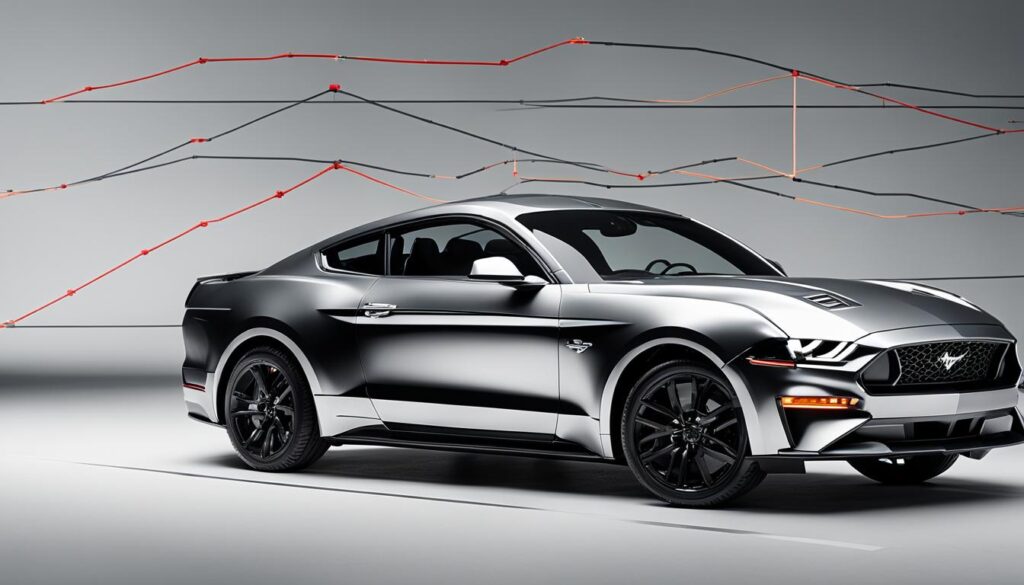
To render a more detailed perspective, consider the following data extrapolated from industry analyses which demonstrate the Mach-E’s depreciation trajectory:
| Years After Purchase | Expected Annual Depreciation | Projected Resale Value | Retention Rate |
|---|---|---|---|
| 1 | $4,680 | $44,374 | 90.46% |
| 2 | $8,761 | $40,293 | 82.14% |
| 3 | $9,811 | $39,243 | 80.00% |
| 4 | $10,792 | $38,262 | 78.00% |
| 5 | $11,773 | $37,281 | 76.00% |
Understanding the Mach-E’s depreciation rates enables potential buyers to make data-driven decisions. It’s evident that while the electric crossover experiences depreciation, its retention rate trends display a slower downward curve in comparison to other vehicles. Bolstered by compelling performance metrics and a nameplate with storied significance, the Mach-E stands to redefine EV market value dynamics. By carefully observing its depreciating patterns over the years, owners can strategically position themselves to maximize resale value and minimize loss.
Ultimately, with a proactive approach toward ownership, including considering factors such as demand, technological developments, and brand stature, one can engage with the Mach-E not just as a automobile but also as an investment with potential for value retention in a rapidly shifting market.
Impact of Mileage and Condition on Mach-E Value
Engaging with the Ford Mustang Mach-E means appreciating its potential as a vehicle that marries performance with pioneering technology. Central to realizing this potential is understanding the impact of mileage and condition on its long-term value. These two factors are among the most significant drivers behind the Mach-E’s resale value considerations, with each requiring deliberate attention from current and prospective owners alike.
The condition-based value retention of the Mach-E underscores the importance of diligence in maintenance, emphasizing the repercussions on the vehicle’s future market value. This section explores the nuanced relationship between mileage, condition, and their combined effect on the Mustang Mach-E’s depreciation, offering a guide to optimize investment returns in the evolving landscape of electric vehicles.

Average Mileage Impact on Resale
Mileage—often a proxy for age and usage—plays a pivotal role in value determination. A Ford Mustang Mach-E with lower mileage typically signifies a vehicle that might have been subjected to less wear, thereby retaining more of its intrinsic value. Conversely, a Mach-E accumulating miles at a pace above the industry-standard annual average can expect a faster depreciation rate, affecting its resale prowess.
How Vehicle Condition Affects Depreciation
Apart from the odometer reading, the Mach-E’s condition casts a significant shadow on its depreciation. A well-maintained vehicle can defy standard depreciation rates, maintaining a competitive edge in the used market. Various facets, such as the exterior’s appearance, the interior’s preservation, and the mechanical integrity upheld through documented servicing, contribute to this condition-based value retention. On the other hand, signs of neglect or unaddressed wear can rapidly erode value, making condition a non-negotiable aspect in resale value considerations.
| Years of Ownership | Mileage | Condition | Resale Value Impact |
|---|---|---|---|
| 1 Year | Under 12,000 miles | Like New | Minimal Impact |
| 3 Years | 36,000 miles | Well Maintained | Moderate Impact |
| 5 Years | 60,000+ miles | Visible Wear | Significant Impact |
The stark differences underscored in the table above illustrate how mileage and condition confluence to mold the Mustang Mach-E’s resale trajectory. Bearing this knowledge, owners can navigate the pre-owned market with heightened awareness, tailoring their usage and maintenance habits to safeguard their Mach-E’s value. As a beacon in the realm of electric vehicles, ensuring value preservation through meticulous care and mindful driving patterns can not only enhance personal satisfaction but can favorably influence the impact of mileage on Mustang Mach-E’s allure in the competitive resale arena.
Comparative Analysis: Ford Mustang Mach-E vs. Other Electric Vehicles
In the landscape of electric mobility, the Ford Mustang Mach-E stands out not only for its storied nameplate but also for its value retention capabilities. A crucial component of an electric vehicle’s long-term appeal is its ability to maintain value over time, signified by its depreciation rate. When assessing the Mach-E depreciation forecast, industry analysts portray a vehicle that has carved a niche within the burgeoning EV market. Competing head-to-head with giants like the Tesla Model Y, the Mach-E’s retained value is a testament to its potential longevity and appeal.
This analysis delves into the heart of the EV competitive market analysis, placing a particular focus on the value comparison among EVs. Criteria such as driving range, cargo space, and the overall comfort of the vehicle paint a clear picture of where the Mustang Mach-E lines up alongside its counterparts. Below is a detailed table that encapsulates the core metrics in a side-by-side comparison with one of its closest competitors, the Tesla Model Y.
| Category | Ford Mustang Mach-E | Tesla Model Y |
|---|---|---|
| Initial Asking Price | $49,054 | $60,990* |
| Retained Value Rating (Out of 10) | 7.1 | 9.3 |
| Safety Rating | 8.0 / 10 | 10.0 / 10 |
| 5-Year Depreciation Forecast | 24% Depreciation | Approximately 40% Depreciation** |
| Driving Range | Approximately 300 miles per charge | Up to 326 miles per charge |
| Cargo Space | 34.4 cubic feet | 76.2 cubic feet with seats down |
| Comfort and Features | Quality interior with intuitive infotainment | Spacious design with state-of-the-art tech |
While the Tesla Model Y stands out with a higher saved value and an impeccable safety rating, the Mustang Mach-E advocates for itself with a balance of affordability and commendable features that cater to a different segment of the market. Although the table clearly delineates a head-to-head with the Tesla Model Y, it’s important to recognize that within the EV competitive market, numerous other players influence the value landscape.
Through this comparative evaluation, it becomes evident that choosing an electric vehicle goes beyond just an environmentally conscious decision—it’s a move that necessitates forethought about performance, comfort, and most significantly, a vehicle’s resilience in holding its value over time. The Mustang Mach-E, with its blend of American muscle heritage and electric efficiency, represents a facet of this diverse and competitive market.
*Price as of the latest update, subject to change
**Based on current market analysis, actual depreciation may vary
Mustang Mach-E Depreciation Factors Influencing Resale Value
Studying the resale ecosystem of the Ford Mustang Mach-E reveals several intricate nuances that directly influence its depreciation trajectory. Among these facets, market dynamics, technology integration, and brand legacy emerge as pivotal elements shaping the Mustang Mach-E depreciation factors.
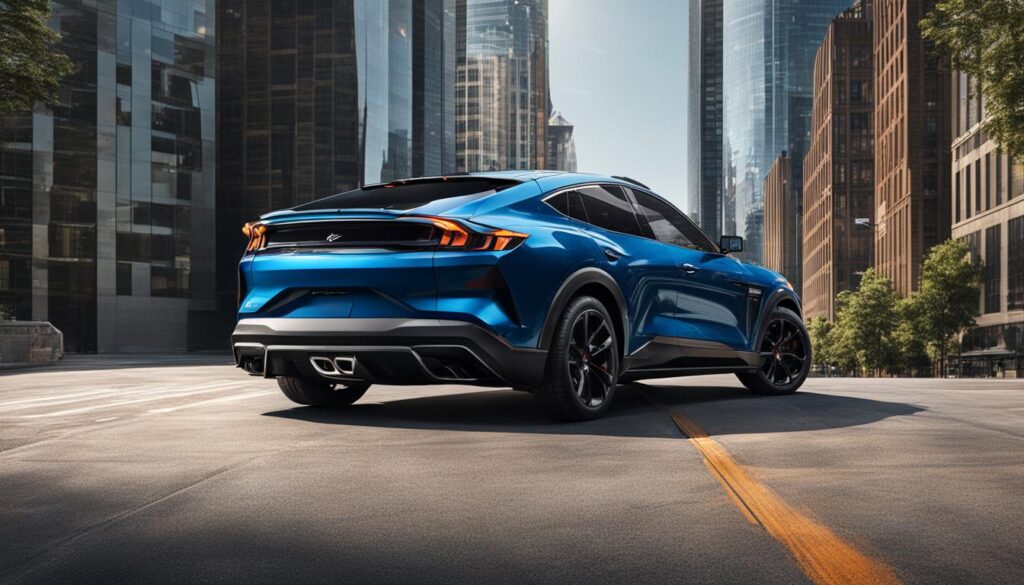
The Role of Market Demand
The electric vehicle (EV) marketplace is in a state of rapid evolution, and within this context, market demand stands as a crucial component in the valuation of electric vehicles like the Mach-E. Market demand effects are seen through shifts in consumer preferences and federal incentives, which have a tangible impact on electric cars‘ desirability and, correspondingly, their depreciation rates. A heightened demand for the Mach-E, driven by its efficient performance and eco-friendly nature, can lead to slower depreciation and a higher resale value.
Technological Advancements and Their Impact
Technology serves as the backbone of modern electric vehicles, and the Mustang Mach-E is no exception. The technological impact on resale is undeniable, with factors such as battery longevity, energy efficiency, and user-centric infotainment systems playing a significant role. As the Mach-E incorporates cutting-edge technology, it not only offers an enhanced driving experience but also positions itself as a competitive model less likely to succumb to rapid devaluation in the technology-driven EV market.
The Significance of Brand Perception
Lastly, the esteemed value of the Mustang lineage cannot be overlooked when discussing brand influence on value. Ford’s commitment to innovation and performance has been consistently encapsulated in the Mustang heritage, and the Mach-E benefits from this legacy. A strong brand perception that meshes with quality and reliability tends to bolster a vehicle’s standing in the second-hand market, aiding in the retention of its value and providing a bulwark against steep depreciation.
| Depreciation Factor | Impact on Mustang Mach-E |
|---|---|
| Market Demand | Increases desirability; can reduce depreciation rate |
| Technological Advancements | Enhances driving experience; may slow devaluation |
| Brand Legacy and Perception | Strengthens resale position; promotes value retention |
Mach-E Depreciation Rate: What Buyers Should Know
Investing in a Ford Mustang Mach-E represents both a step into the future of automotive technology and a financial commitment that must be scrutinized with a keen eye for anticipated depreciation rates. In getting to grips with understanding Mach-E depreciation, prospective buyers are equipped with a crucial pillar of knowledge that supports smart electric vehicle investment decisions.
In light of the Mach-E’s anticipated healthy retention of value, it’s essential for buyers to deliberate on various factors that buffer against the depreciation curve. Brand popularity, novelty, and the promise of future tech integrations inform the rate at which the Mach-E’s value may decline. These elements cast long shadows across the landscape of electric vehicle ownership — from immediate depreciation upon leaving the dealership to the long-term financial implications.
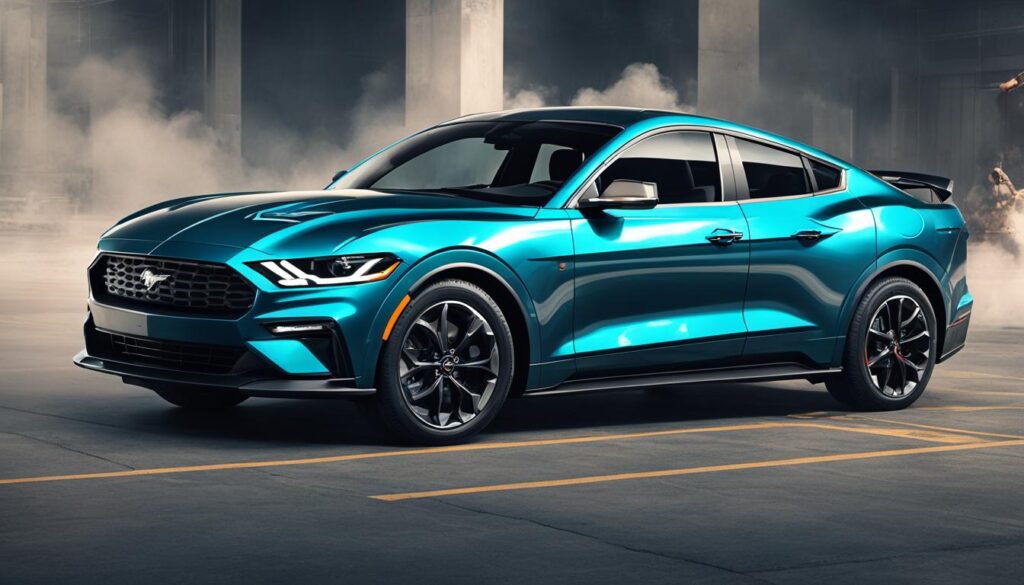
To anchor our predictions, let’s scrutinize the data that captures the depreciation contour for a five-and-beyond-year horizon. Figures below echo the Mach-E’s journey as a vehicle that does not just drop in value but glides along a calculated gradient of fiscal descent, backed by its distinct standing in the electric vehicle market.
| Years After Purchase | Percentage of Value Retained | Resale Value (Estimate) |
|---|---|---|
| 1 | 90% | $44,148 |
| 2 | 85% | $41,695 |
| 3 | 80% | $39,243 |
| 5 | 76% | $37,281 |
The table guides the buyer through a vista of numerical expectations, demystifying the true cost of ownership associated with an electric powerhouse like the Mach-E. Understanding that the Mach-E’s depreciation rate is tethered not only to time but also to broader market sentiments, tech relevance, and societal shifts towards green technology, provides a powerful vantage point from which to navigate the complexities of EV investments.
For the astute buyer, these anticipated depreciation rates serve as a financial compass. By weighing the Mach-E against industry benchmarks and competitor models, one can ascertain not just the devaluation but also the enduring value of Ford’s electric vehicle ingenuity. With these insights, the buyer transcends from the merely curious to the competently informed, ready to make a purchase that resonates with personal values, meets performance expectations, and aligns with fiscal realities.
Prospective Resale Value: Mach-E Depreciation Analysis
When it comes to electric vehicles, the adage “what goes up must come down” rings particularly true in the context of car values. Yet in the midst of this reality, the Ford Mustang Mach-E emerges as an impressive exception that might defy conventional wisdom. Mastering the art of forecasting Mach-E resale value is a complex, yet crucial endeavor for those engaged in long-term financial planning for EV owners. With meticulous resale analysis of Ford electric vehicles, particularly the Mach-E, we are able to extrapolate potential market trajectories and the factors which may lead to optimal value retention.
Advancements in the realm of electric mobility have positioned the Mach-E as an appealing option in the resale market. Looming questions persist, however, regarding how well this model can maintain its worth in the face of advancing technology and evolving buyer preferences. In the scope of this resale analysis, several indicators point toward a promising outlook for the Mach-E, advocating for its potential to secure a moderate retention of its value after the five-year mark—a reassuring signal for electric vehicle investors.
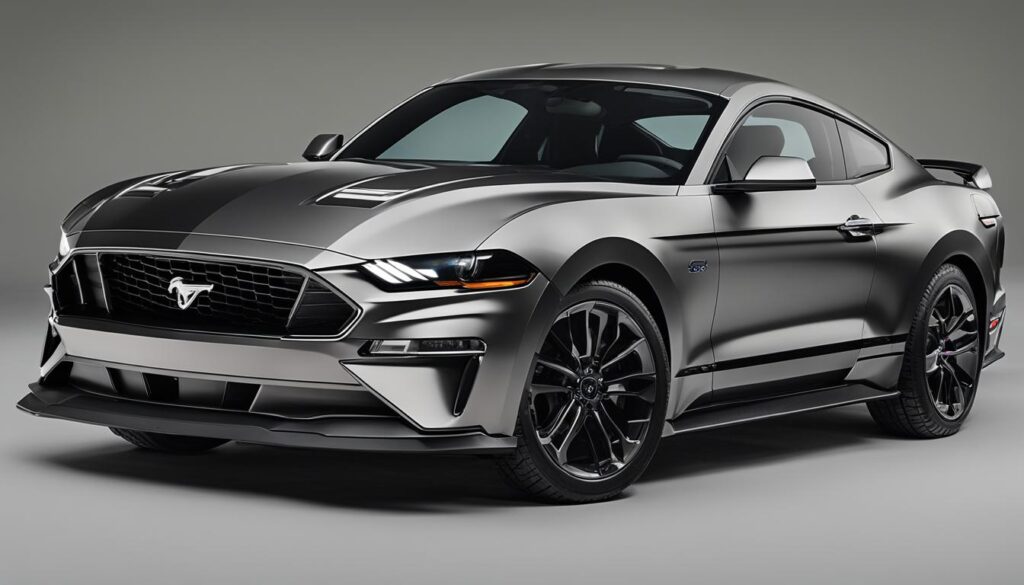
Several influential variables factor into the Mach-E’s depreciation estimate. Continual improvements in EV range, sustainable production practices, and incremental but inevitable advancements in battery technology all play their part. Furthermore, the Mach-E benefits from the generally increasing allure of eco-friendly transportation solutions among the consumer base, which may augur well for its long-term appeal.
Of course, these signals must be sifted through the fine-meshed sieve of real-world market conditions. Shifts in the economic landscape, fluctuations in consumer demand, and legislative trends towards sustainability can all radically influence the Mach-E’s market performance, for better or worse. As is the case with any prudent financial forecast, a degree of uncertainty is to be expected and accounted for.
- Maintaining top-notch vehicle condition is a key determinant of resale value.
- Market conditions and consumer trends greatly impact the desirability and thus the depreciation rate of EVs, including the Mach-E.
- Anticipated improvements in electric vehicle technology could significantly alter the calculus of Mach-E resale values.
In the final reckoning, those intent on preserving their Mach-E’s resale value would do well to heed the lessons drawn from a detailed resale analysis. By keeping an eye on emerging EV technologies, predicting shifts in market demand, and offering meticulous maintenance, owners can align their expectations with a more accurate forecast of their vehicle’s fiscal fate.
Tips for Maximizing Ford Mustang Mach-E Value Retention
For enthusiasts and investors alike who recognize the Ford Mustang Mach-E as more than just a mode of transportation, but as an asset with potential for value retention, certain strategies come to the fore. These thoughtful approaches can effectively slow the natural depreciation of this electric marvel, maximizing its resale value in a dynamically shifting market.
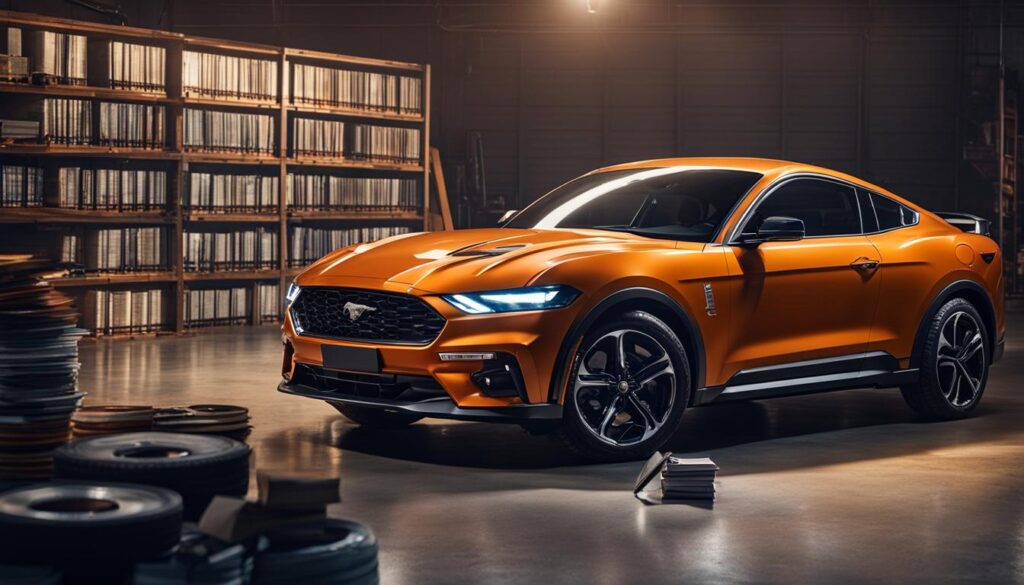
Proper Maintenance and Care
One of the foundational elements in maintaining Ford electric vehicles such as the Mach-E is adherence to scheduled maintenance and care. The perception of a well-maintained vehicle extends beyond curb appeal to signal intrinsic value, driving up its desirability. For owners eyeing maximizing Mach-E value retention, the checklist is comprehensive: timely oil changes, tire rotations, battery checks, and ensuring that every aspect of the vehicle conforms to the manufacturer’s specifications. The meticulous attention to care fortifies against accelerated depreciation and stands as a beacon for prospective buyers.
Timing the Market: Best Resale Scenarios
Understanding the nuances of the automotive resale market, especially that of electric vehicles, translates into strategic resale timing. Selling the Mach-E when it’s still relatively new, before a major model update diminishes the perceived value of older models, can significantly mitigate loss. Additionally, taking advantage of periods of high demand—often fueled by shifts in consumer trends or tax incentives—can also provide leverage for the seller. Astute owners will surveil market trends, government policies, and brand announcements to ensure they strike when the market favors their Mach-E’s worth.
In summary, a holistic approach to ownership—comprising vigilant upkeep and strategic foresight in the sale—constitutes a robust strategy for owners to elevate the financial viability of their cherished Ford Mustang Mach-E.
Conclusion: The Trajectory of Ford Mustang Mach-E’s Value
As we reflect on the future of Mach-E depreciation, it becomes clear that the Ford Mustang Mach-E is charting a confident course through the uncharted waters of electric vehicle depreciation. With its strong performance, advanced technological features, and the undeniably rich legacy of its brand, the Mach-E demonstrates resilience in an ever-fluctuating market, foreshadowing a formidable presence in the electric vehicle sector. Owners of the Mach-E are endowed with the knowledge that their vehicle’s appeal may extend well beyond its cutting-edge specs — into a future where electric mobility is standard.
Final thoughts on Ford Mustang Mach-E resale value hinge on various dynamic factors that owners can strategically navigate. The crux of value maintenance seems to hinge on proactive measures such as diligent maintenance and market awareness. Such actions have the power to positively skew the depreciation rate, safeguarding the investment made in this embodiment of modern automotive evolution. Over time, the well-maintained Mach-E is not just a personal statement or environmental commitment; it’s also an economic asset with a well-buffered depreciation curve.
In synthesizing our closing insights on EV market positioning, the Mustang Mach-E stands out as a pathfinder revealing what the integration of heritage, sustainability, and performance can yield. Its presence in the burgeoning EV landscape echoes Ford’s dedication to redefining the traditional vehicular experience, making Mach-E a significant player in the discourse on value retention. For those captivated by the allure of the Mach-E as well as prospective EV adopters, the procession towards electric avenues seems less daunting knowing that such a vehicle does not only promise thrilling rides, but also a strategic edge in the resale market.
FAQ
What is the current depreciation rate of the Ford Mustang Mach-E?
The Ford Mustang Mach-E experiences an estimated depreciation rate of approximately 24% over five years, which means it maintains a resale value of around $37,281, based on an original purchase price of $49,054.
How does the electric vehicle market adoption impact the Mach-E’s value retention?
The growing adoption of electric vehicles, due to increased environmental awareness and technology advancements, positively impacts the Mach-E’s value retention as it pertains to an expanding market with a growing customer base.
What are the key trends in Mach-E depreciation over time?
The key trends in Mach-E depreciation indicate a stronger hold in the used car market compared to many other models, ranking it in the top quarter for resale value after five and seven years, with a projected residual value of 47.90% after ten years, assuming an average annual mileage of 12,000 and proper vehicle maintenance.
How does average mileage impact the resale value of the Mustang Mach-E?
Average mileage has a significant impact on the Mustang Mach-E’s resale value. Generally, lower mileage indicates less wear and tear, leading to a higher resale value due to the perceived extended longevity and reduced maintenance costs.
How does vehicle condition affect the Mustang Mach-E’s depreciation?
The condition of the Mustang Mach-E directly affects its depreciation. A well-maintained vehicle with minimal wear and tear holds its value better than one that has been neglected or damaged, emphasizing the importance of regular maintenance and care.
How does the Mustang Mach-E compare to other electric vehicles in terms of resale value?
The Mustang Mach-E holds a competitive position in terms of resale value when compared to other electric vehicles. It competes closely with popular models like the Tesla Model Y, with value retention being influenced by factors like driving range, vehicle features, and overall brand reputation.
What factors are influencing the resale value of the Mach-E?
Resale value of the Mach-E is influenced by market demand, technological advancements, and brand perception. High market demand can sustain the Mach-E’s value, while technological features and the Mustang legacy contribute to its appeal and market strength.
Why is it important for buyers to understand the Mach-E depreciation rate?
It is essential for potential buyers to understand the Mach-E depreciation rate to make informed decisions regarding their purchase, navigate the trade-offs between new and used models, and plan for long-term costs associated with vehicle ownership.
What does the forecast look like for Mach-E’s resale value?
The forecast for the Mach-E’s resale value is moderately promising, with a good value retention rate anticipated after five years. This projection assumes favorable market conditions and continued advancements in EV technology and infrastructure.
How can owners maximize the resale value of their Ford Mustang Mach-E?
Owners can maximize the resale value of their Mach-E through diligent maintenance, keeping the vehicle in excellent condition, and strategically timing its sale to coincide with high demand and before major model updates that could impact the value of older models.
